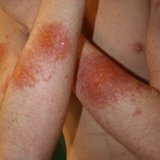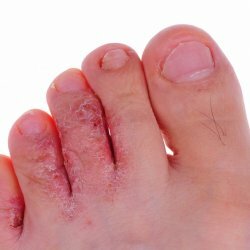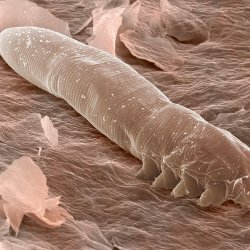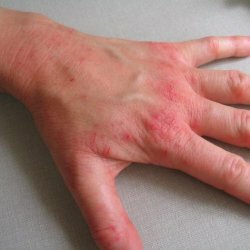Allergic contact dermatitis

Symptoms of dermatitis
The most obvious symptoms of allergic dermatitis can be called: itching, redness of the body, the appearance on the skin of blisters with fluid and erosion. The most effective methods of treatment are: the use of ointments from inflammation, the use of antihistamines and complete exclusion of contact with the allergen.
What is allergic contact dermatitis?
This disease is an allergic skin inflammation, after interaction with any irritant or allergen.
Contact dermatitis has two phases of development: the phase of sensitization( when the body produces immune substances) and the phase of clinical manifestations( contact dermatitis itself).
The first phase lasts approximately 2 weeks( the very first contact with the allergen), the person does not notice it. At the end of this phase, the body starts producing certain substances that, during the next interaction with the allergen, cause the strongest allergic reaction. In the case of the next contact with the allergen, sensitized immune skin cells produce inflammatory mediators. The most important mediator is histamine. When exposed to the skin, this substance also causes inflammation, itching, swelling.
Why does contact dermatitis develop?
Allergy - an increased reaction of the body to some substances, allergens, a tendency to this is inherent in genetics. Since mainly those who suffer from dermatitis, there are relatives with the same disease. The most common substances that cause contact dermatitis are:
Nickel is a metal used for making various ornaments( rings, chains, earrings, etc.), dishes, coins, dentures, buckles of belts.
Latex - used to make gloves made of rubber, condoms, nipples for children.
Some medicinal creams: corticosteroid creams and antibiotics, as well as others.
Cosmetics for skin care products: shower gels, creams, shampoos, etc.
Clothing: a number of materials that are used to make clothes.
Household chemical products: dish gels, washing powders, etc.
Many other substances: ink, glue, paints.
It is worth saying that this disease can develop in any person and on any substance.
Symptoms and signs of allergic contact dermatitis
Basically, the redness of the skin in this disease is called eczema. The first signs may appear after a while, not immediately.
The main manifestations of allergic contact dermatitis:
The area of skin that has had contact with the allergen, reddens and swells.
Severe itching in the area of the skin that has blushed.
Bubbles of different sizes with liquid appear on the skin.
If the bladder bursts, then in its place is obtained erosion - a site without a superficial skin layer, painful.
If the skin becomes inflamed, yellow crusts remain in its place.
Large inflammation in the place where jewelry was( earrings, bracelet, piercing) often means infection, not contact dermatitis. If it is all the same contact dermatitis, the inflammation is not treated with ointments and antibiotics, treatment of wounds with solutions that cauterize.
Diagnosis of allergic contact dermatitis
Contact dermatitis is diagnosed with special application tests - the skin is put on the supposed allergen and a reaction is observed. Such tests identify substances that can cause allergy in a particular person. The detection of such an allergen is very important in the treatment of the disease, often patients themselves know what they are reacting to.
Treatment of allergic contact dermatitis
The most necessary rule for the treatment of allergic contact dermatitis is the complete elimination of skin contact with a substance that causes an allergic reaction.
If any decoration causes an allergy, it must be removed and postponed, maybe for good. If allergic dermatitis occurs, when contact is made with allergens in the workplace, it is worth using protective equipment: mask, gloves, protective suit.
In case of accidental contact of the stimulus on the skin, it should be washed off with soap and water more quickly and the skin dried well with a towel.
If there is an allergy to household chemicals( dishwashing detergents, washing powders, etc.), these funds should be discontinued, hypoallergenic drugs may become an alternative.
When contact allergic dermatitis occurs on nickel, it is necessary to introduce a diet that excludes foods with a high content of nickel, for example: buckwheat, oatmeal, soybean, millet, tomato, chocolate, etc.
Drugs used in the treatment of contact dermatitis
It was said, the main factor of skin inflammation is histamine, therefore, in order to cure contact dermatitis, you need to take antihistamines. Now a lot of such drugs, which are very modern( Telfast, Erius, Zirtek, etc.), they have no side effects, like the antihistamines of the past( Dimedrol, Suprastin, Tavegil, which reduces attention and appears drowsy).
Erius is released in tablets of 5 mg each. In order to cure contact dermatitis in adults and children over 12 years of age, one tablet of the drug per day is needed. Zirtek is released in the form of tablets of 10 mg, they take one tablet once a day.
If skin inflammation is severe and accompanied by blistering and erosion, local treatment with ointments based on corticosteroids( inflammatory agents), for example: Elidel, Lokoid, Advantan and so on, is necessary. Advantan is applied in a thin layer to the site of inflammation once a day, the course of treatment is 3-5 days. A longer period of time is undesirable to use ointment.
In case contact dermatitis appears on the face, the use of the Advantan emulsion is necessary. The emulsion is applied in a thin layer and is rubbed a little, it needs to be done once a day.
Allergic dermatitis should be treated under the supervision of professional dermatologists or allergists.



